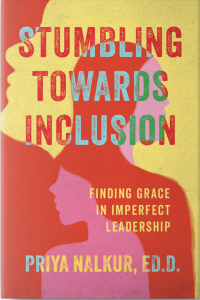Priya Nalkur – who holds a Harvard degree in human development and psychology – is one of America’s most in-demand executive coaches.
With a passion for coaching executives about how to be the leaders they are ‘meant to be,’ she is president of The RoundTable Institute.
Later this month (April 16th), she publishes her first book – Stumbling Towards Inclusion – which is available to pre-order now.
To mark the arrival of this book, TLNT has this exclusive excerpt on how inclusive leaders can cultivate psychological safety.
(To order her full book, click here)

How do we create psychological safety?
An organizational culture marked by psychological safety is one that values and makes space for each and every voice.
But how do we go about creating psychological safety in our organizations? And just as important, how can we maintain and deepen it? How do we even know when it is running strong, and how do we know when it is waning?
While all these questions are important, the last question in particular is critical because building psychological safety is not a one-off matter.
It is not like physical infrastructure where, once it’s in place, it only needs a little cleaning and maintenance now and then.
Far from it. Psychological safety is the psychological, relational infrastructure of your organization, and it must constantly be attended to.
Think of it like a relationship. Falling in love is only the first step. Sustaining the relationship is an ongoing, long-term process of reading, listening, checking in, and deepening mutual understanding.
Treat it like your garden
Psychological safety will have its ebbs and flows. But a good way of thinking about it is that keeping it healthy is like tending a garden.
This is because psychological safety is a dynamic, which means that it happens within and between people.
In this sense, it is not a given; it must be developed, and it requires effort.
There are specific behaviors that go into building such healthy relationships.
You must get to know your colleagues and coworkers in a meaningful way by listening to them and by asking questions that demonstrate you are genuinely interested in them.
Likewise, you need to meaningfully and authentically share who you are. Tell them what you did on the weekend; talk about your hobbies and family; take risks in being vulnerable.
Additionally, you should demonstrate concern. Proactively ask how employees are doing; show them empathy, and ask how you can Help.
Understanding the connection between feedback and safety
My own observations suggest that being mindful of your feedback practices goes a long way toward building psychological safety.
Feedback is a very specific relational skill that is enormously important in the workplace.
But what might be termed in-the-flow-of-work feedback is critical in its own right.
One of the reasons sports are so conducive to flow is they provide immediate and clear feedback as to how we are doing.
In a race, you can tell whether you are behind or ahead of your closest competition. In basketball, you know whether your form is correct when the ball either goes in the net or doesn’t.
We need that moment-to-moment feedback at work as well, but we often don’t get it.
Provide (correct) help to grow
A majority of employees will say they want to be “developed” in their jobs – that they want clear, usable feedback to help them grow and improve.
But only a third say they actually get the feedback they need.
A big reason for this gap is that feedback can be scary.
Constructive feedback, which often has an element of criticism involved, can feel like a threat.
We respond physiologically to perceived social threats just as we do to perceived physical threats.
This heightened fight-or-flight state doesn’t lend itself to taking criticism well.
But a study by the NeuroLeadership Institute found that when someone actively asks for feedback, this defensive reaction can be significantly mitigated.
It’s also easier on the person giving the feedback, as the request for feedback usually indicates what kind of feedback the person is looking for.
When employees actually ask for feedback, it can avoid another big pitfall: what psychologists sometimes call the “brittle smiles” phenomenon. This is when the one giving the feedback feels compelled to be “nice” and overcompensates instead of speaking clearly and candidly. Researchers measured heart rates during such exchanges and found that, while they may appear to be “friendly” on the surface, both parties were, in fact, feeling terribly anxious.
Create challenges
Psychological safety doesn’t mean people aren’t challenged.
It’s not about being “nice.”
Candid, no-BS feedback challenges people to step up their game and perform at a level you know they can achieve.
Implicit belief in someone – where a leader may believe in them more than the employee may believe in themselves – can really build safety.
When leaders believe in someone and confirm that belief with their words and actions, the person they believe in will be more likely to take risks, be creative, and innovate.
When couched like this, employees know leaders will support them even if they mess up.
Similarly, acknowledging and celebrating successes by sharing credit is critical to building psychological safety. People want to know that they are valued.
Intentionally celebrating wins and acknowledging individuals for their efforts and results goes a long way in building safety.
Give consistent micro-affirmations
Micro-affirmations are nonverbal and verbal gestures that demonstrate concern, care, and encouragement.
Nods, smiles, word choice, and check-ins are examples. They also do a lot of good legwork and do the job of affirming and offering safety.
Don’t break it!
But while we’re on the topic of its power, it’s also important to point out just how fragile psychological safety is, and how quickly it can be eroded (often unintentionally), by opposing behaviors, like micro-aggressions.
Other corrosive behaviors include unequal participation, favoritism, blame, defensiveness, and various forms of passive-aggressive behavior.
Those are fairly obvious examples of behaviors that can create a sense of psychological unsafety, although their expression can sometimes be subtle and insidious.
Yet there are more nuanced instances as well. For example, how you react when someone has an emotional episode at work can affect safety.
When someone cries at work, do you get visibly uncomfortable, somehow communicating that this isn’t a safe place to cry? Or do you yourself hold back tears (or cry with them), express concern, and lean into them in a way that shows it’s okay to cry?
Claim your own psychological safety
The emotional intelligence required for inclusive leadership involves paying attention to- and taking care of- your own needs as well.
This certainly applies to psychological safety. What constitutes safety varies a good deal from person to person.
What do you need to feel safe?
Answering and acting on this question is important.
Unless you tend to your own psychological safety, you won’t take the necessary risks, show the necessary vulnerability, or extend the full generosity of spirit to others that great inclusive leadership demands.
If you talk explicitly about your own safety and name what you need to feel safe, you will be modeling that same behavior for others.
Stumbling Toward Inclusion, ©2024 Priya Nalkur. Published by Amplify Publishing Group, Inc.
